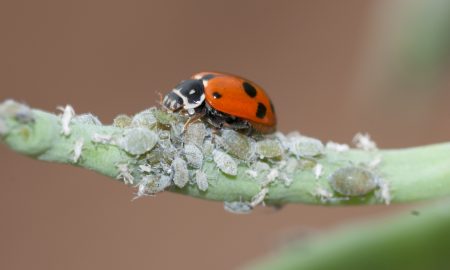There is still much to be learnt about the relationship between millipedes, stubble management practices and crop loss, but we edge closer.
Where have they been reported?
Black Portuguese millipedes, and possibly other pests (earwigs and crickets), have damaged about 25% of a two-leaf canola variety trial in the Lismore region of Central Victoria. The pests have been nibbling cotyledons and leaves.
We have also recorded Twitter reports of millipedes damaging canola in Central Victoria (Skipton to Clunes) and at Yarrawonga (Victorian Northern Country).
Millipede samples taken from a damaged canola crop near Lockhart in the NSW Riverina were identified as native millipedes; these are not generally considered a pest.
Overall, however, there have been relatively few reports of millipedes this season.
About this pest
It is likely that populations of black Portuguese millipede (Ommatoiulus moreletii) have increased in no-till and stubble retained systems (low disturbance) over recent years because of increased soil moisture and organic carbon levels.
Millipedes have a two-year lifecycle. Adult females lay eggs into the soil during autumn or early winter. When juveniles hatch from eggs they are initially legless and largely immobile.
Millipedes can be present in high numbers within a paddock without damaging a crop. Feeding damage is infrequent because millipedes predominantly feed on organic matter such as leaf litter, decaying wood and fungi.
Laboratory research by Josh Douglas (The University of Melbourne) has shown significant differences in the susceptibilities/plant host preferences of black Portuguese millipedes.
Millipedes exposed to different crop seedlings caused substantial damage to lupins, lucerne and canola and very little or no feeding damage in wheat, oats, chickpeas, faba beans or lentils. This research points to the likely risk of different crop types under field conditions, although further work is needed.
We would be particularly interested to hear of reports of crop damage by millipedes of seedling cereals or pulses.
In field surveys, Josh has found no evidence that millipedes survive in crops over summer; in contrast he believes that most damaging infestations result from millipedes re-entering stubble-laden paddocks from crop boundaries in autumn.
Click here for more comprehensive information on millipedes, including their occurrence, lifecycle, behaviour and management strategies
Our advice
Monitoring of canola paddocks with high numbers of millipedes is recommended.
Be sure to distinguish millipede damage from that of other pests, such as slugs.
If millipedes are found within paddocks, a night time visit will help determine if they are feeding on crop plants – as millipedes are mainly active and feed at night. During the day, it is best to search under rocks, stubble residue, wood, or to dig up the soil with a spade. Refuge traps such as carpet squares, tiles or pot plant bases can be used to detect millipedes.
There are currently no insecticides registered against black Portuguese millipedes in broadacre crops. Field reports suggest fipronil seed treatments are effective in controlling millipedes (assuming the pest loads are not too heavy).
Acknowledgements
Source of field reports of black Portuguese millipedes
Josh Douglas – Researcher, The University of Melbourne
Kat Fuhrmann – Regional Research Agronomist, Agriculture Victoria, (Central Victoria)
Warwick Nightingale – Agronomist, Delta Ag (NSW Riverina)
Tom Toose (@ttoose)
Dan walsh (@walshagro)
Cover image: Photo by Andrew Weeks, Cesar Australia





